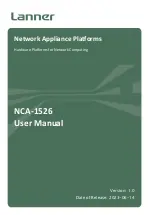
TOPEX Bytton (HSPA+ / LTE)
ByttonLTE(full)_genericUsermanual_sw306FAS_revN.1.docx
Page: 285 / 290
SPI uses smart rules, thus enhancing the filtering process and controlling the network session. Static
packet filtering cannot stop DOS attacks. But SPI closes ports until legitimate users request them opened
so it prevents certain kinds of Denial of Service attacks. Since SPI firewalls compare packets to previous
packets, the packets that violate the rules can be dropped.
TCP/IP
– Acronym for Transmission Control Protocol / Internet Protocol. It was established by the
Defense Department of the USA for communications between computers. It has been at first incorporated
in Unix operating system but has become the de facto standard for data transmission via networks,
including for Internet.
TCP
– Acronym for Transmission Control Protocol. In TCP/IP, the TCP part is the one that takes care of
keeping track of the individual units of data (packets) that a message was divided into for efficient routing
through the Internet. TCP is known as a connection-oriented protocol, which means that a connection is
established and maintained until the message or messages to be exchanged by the application programs
at each end have been exchanged. TCP is responsible for ensuring that a message is divided into the
packets that IP manages and for reassembling the packets back into the complete message at the other
end.
At the destination, TCP reassembles the individual packets and waits until they have all arrived to forward
them to you as a single file. It also checks the received packets. TCP acts at the transport level (level 4) of
the ISO/OSI model. See also ISO/OSI model, packet, TCP/IP.
UDP
– Acronym for User Datagram Protocol. It is a simpler protocol than TCP/IP that corresponds to the
transport layer of the ISO/OSI model. UDP converts the messages generated by the application into data
packets to be sent through IP, but does not check if the messages have been transmitted correctly or not.
UDP allows individual packets to be dropped (with no retries) and UDP packets to be received in a
different order than they were sent. Consequently UDP is more efficient but less reliable than TCP and is
used to different purposes - primarily for broadcasting messages over a network. With UDP, reliability is
wholly in charge of the application that generates the message.
UDP is used often in applications such as videoconferencing or games where optimal performance is
preferred over guaranteed message delivery.
WAN
- Acronym for Wide Area Network. A system of LANs, connected together. A Wan is a network that
connects computers located in separate areas, (i.e., different buildings, cities, countries). The Internet is a
wide area network.
Bytton LTE features a dedicated WAN port and a configurable LAN/WAN ports, allowing versatile
connection to another network or to alternate broadband service providers via Ethernet cable.
WWAN
– Acronym fo wireless wide area network. Also named "broadband wireless," WWAN refers to
wireless high-speed data networks covering a large geographic area. This broad category can include
2.5G, 3G, 4G, and other types of technology where each base station (tower) is designed to reach an area
measured inmany kilometers. The term WWAN is used primarily to distinguish this group of diverse
technologies from WLANs (Wireless Local Area Networks,) which typically cover a much smaller area, just
300 m from the base station. WLAN includes technology like Wi-Fi.
Wi-Fi type N
– Besides the usual 802.11 b/g WiFi modules, Bytton LTE may be fitted with N-type
Wireless Access Point using dual antennas. 802.11n is the third-generation Wi-Fi standard for wireless
home networking. 802.11n equipment is backward compatible with older 802.11g or 802.11b gear, and it
supports much faster wireless connections over longer distances. It uses several radio modules and
antennas (MIMO) together with channel bonding techniques, which utilizes two adjacent Wi-Fi channels
simultaneously to double the bandwidth of the wireless link compared to 802.11b/g. The 802.11n standard
specifies 300 Mbps theoretical bandwidth is available when using channel bonding. Without it, about 50%
of this bandwidth is lost (actually slightly more due to protocol overhead considerations), and 802.11n
equipment will generally report connections in the 130-150 Mbps rated range in those cases.
As a drawback, channel bonding substantially increases the risk of interfering with nearby Wi-Fi
networks due to the increased spectrum and power it consumes.






































